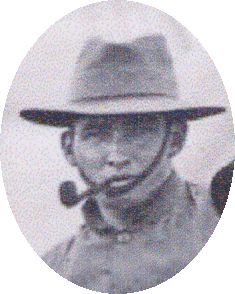Bernard Henry Clarke
Rank: Private
Service Number: 460
Regiment or Corps: 8th Australian Machine Gun Company
Personal Information: Bernard grew up in Tarlee, South Australia. He along with his 7 brothers and 2 sisters all grew up on a farm named Ryelands, and all loved the land. His mother Sophie Jane and his father William Angus both raised their children well and consequently they all lived a successful life in one way or another. His occupation was as a Home Missionary at Lucindale Methodist Home Mission Station, and in April 1916 he went to Caltowie as a Circuit Assistant. During his time in Lucindale he was a member of the Rifle Club there. Bernard is my grandma’s uncle and therefore my great, great uncle.
Enlistment Information: Hearing the news that the Australian Army was calling for volunteers to fight as part of the British Commonwealth, Bernard along with his brother William Angus decided to enlist to go to the First World War on the 23rd of May 1916. They both enlisted at Riverton SA together, hence their unit numbers being 460 and 461. He was passed and sworn in on May 26th and given a social with other boys at Tarlee on the same evening. He was given a Bible from the Church and left Tarlee to enter camp on Monday the 29th of May 1916. At the time of his enlistment he was 20 years old, 6 foot tall, with a fresh complexion, blue eyes and brown hair.
Role in the War 1916
On June 28th he volunteered for the Machine Gun Company. He returned home for the last time before venturing to Melbourne on the 19th of August not knowing that that would be the last time he would ever see his family. He arrived at Melbourne on the 22nd and was driven in a cab to Seymour Camp where he was given the “lovely opportunity” of Squad drills all day. He writes: “pleasing the officers with our drill.”
October 25th-, rowdysism, no sleep. Departure to the boats that day and Bernard seemed quite nervous. They waved farewell as the boat “Ulysses” leaves Port Melbourne. From the 26th October to the December the 28th he was aboard ship. He got quite sick on the boat numerous times.
In England Training
January 1st 1917- January 9th Bernard and his mates went sight- seeing. Westminster Abbey, Parliament Houses, museum, Anzac Cove (hotel) , Zoological Gardens.
Training- Machine Gun work, physical training, Squad and Company Drills, Bomb throwing practices, physical jerks, rifle drills.
April 24th – France/Belgium
Arrived at Folkestone about 6am and left for Bologne at 1pm. Bernard says he slept with Angus that night and spoke of an 18 mile march the next day.
Throughout April May June and July, Bernard talks of his experiences. Going through gas attacks, gun drills, playing cricket in the “afty”, going to the pictures, going to church parades, went rowing and had some drinks, inspections, training, surviving on harsh rations and sleeping throughout the cold nights.
As for August and September Bernard speaks of more violent training and also about the Fritz dropping shrap over the road.
September 14 Fritz shelled all around their posies pretty warmly for a bit. No damage.
September 16 The war was getting more and more harsh. Bernard was on gas guard and Fritz planes were over them that morning.
September 21- 2 of the Australian planes went down near Ypres and 2 did the same up the line further.
September 22 Bernard met up with other soldiers in the 50th Battalion. Fritz tried for balloon again but missed it.
September 24th Fritz dropped some shrap near Bernard. He was repairing the trenches with sand bags etc.
THE BATTLE OF POLYGON WOOD
On the 26th of September 1917 the 5th Division was involved in the Battle of Polygon Wood. Preparations took place very quickly. Food, water, engineering stores and ammunition was secured close to Menin Road. The guns assembled for the barrage to support the Fifth Division infantry was a remarkable force. 205 pieces of heavy artillery, one gun for every nine metres, the usual 18- pounder guns, and then there were the heavy Vickers machine guns of the Machine Gun Companies. This was Bernard’s unit. Shells screamed through the air as the men fought hard for their country. Private Clarke was hit hard by a shell, in which blew off both legs. He died fighting for his country. He was buried at Zonnebeke, Weshoek Wood. Although this battle took the lives of innocent young men, the remaining men of the Fifth Division captured Polygon Wood. A battle never forgotten, always remembered.
Memorial Details: Bernard’s final resting spot was not recovered after the war and he is remembered on the wall of the Menin gate Memorial in Ieper.